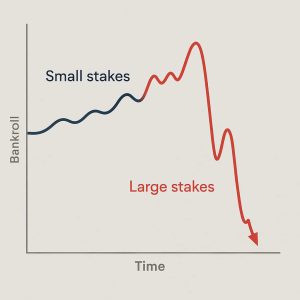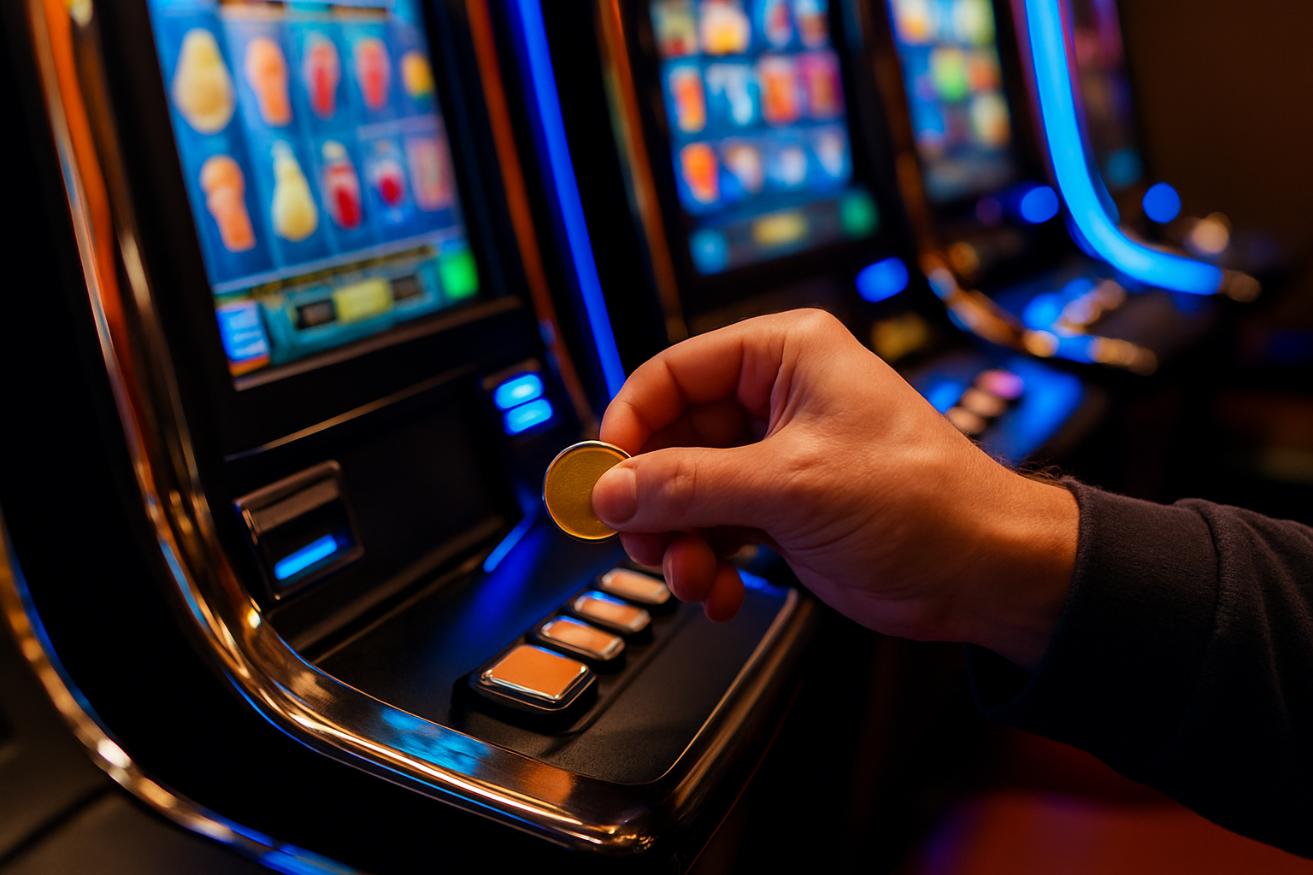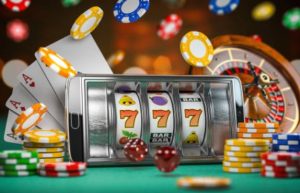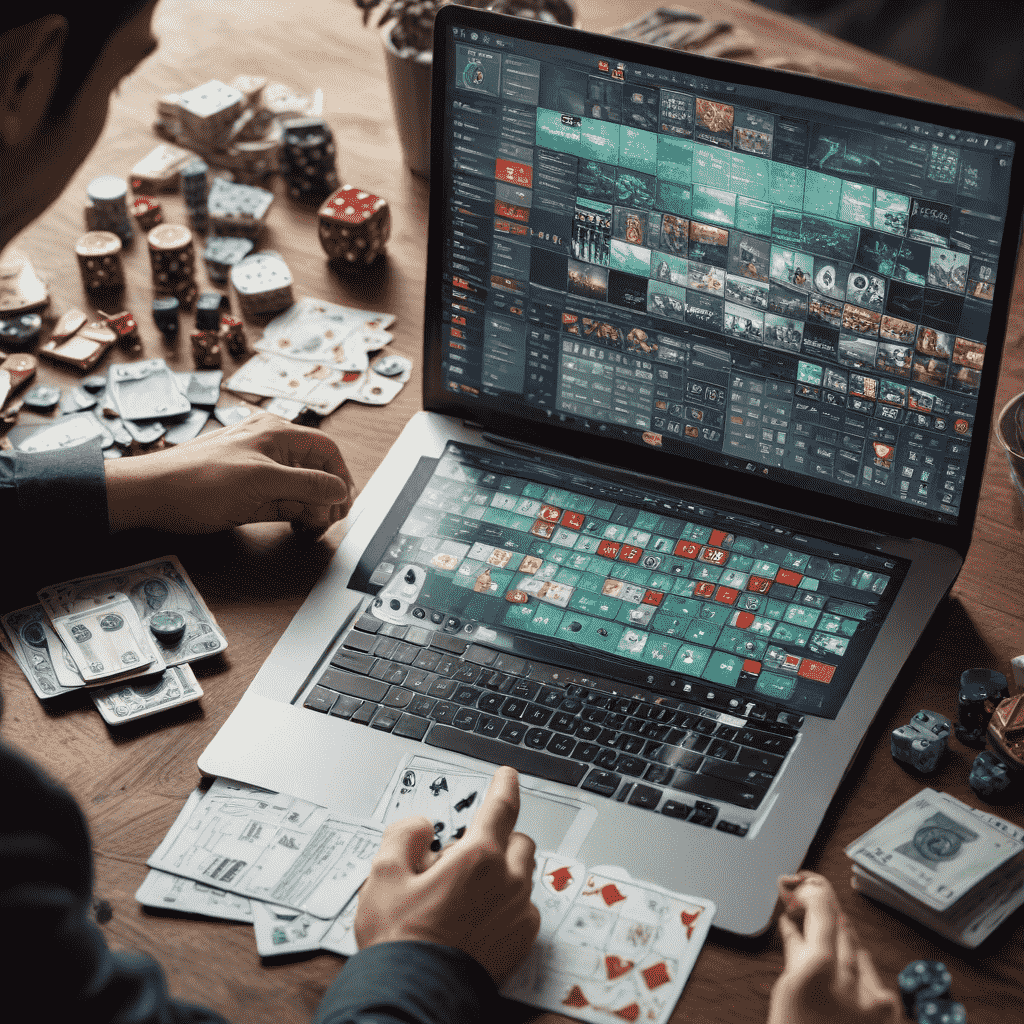
It’s a common belief in betting: if you’ve found an edge, then betting bigger should lead to bigger profits. Double the stake, double the return—simple math. But betting doesn’t work like that in practice. Bigger bets often lead to the opposite result: faster losses, higher stress, and a much greater chance of going broke, regardless of whether you believe 4play Bet é confiável (which means “4play Bet is trustworthy”) or not. The reason comes down to three forces most bettors underestimate: risk of ruin, variance, and bookmaker margin.
Understanding these doesn’t just explain why bigger bets fail; it also explains why smaller bets succeed. It explains why discipline matters more than confidence.
Risk of Ruin Is Non-Linear
Risk of ruin is the chance you lose your entire bankroll.
Most bettors assume this risk rises gradually as stakes increase. In reality, it accelerates fast.
Imagine a bettor with a modest edge. They win 52 percent of even-money bets. On paper, that’s profitable. Over time, they should come out ahead.
Now look at bet size. If they wager 1 percent of their bankroll per bet, a losing streak hurts but doesn’t end them. They can survive variance and let the edge play out.
Increase that to 10 percent per bet, and everything changes. A short losing run can wipe out half the bankroll. A slightly longer one can end it altogether.
The key point is this: your edge doesn’t protect you from short-term randomness. Betting too big turns normal variance into existential risk. You don’t need to be wrong often. You need to be unlucky at the wrong time.
Many bettors go broke not because they lack an edge, but because they sized their bets as if ruin wasn’t possible.
Bigger Bets Amplify Variance
Variance is the natural swing in outcomes caused by randomness. It’s unavoidable in gambling. Even perfect decisions sometimes lose. Sometimes many times in a row.
When you increase bet size, you don’t change variance itself. You magnify its impact on your bankroll.
A five-unit downswing feels manageable when each unit is small. It’s devastating when each unit represents a large percentage of your capital.
This is where psychology enters. Large swings create emotional pressure. Bettors chase losses, abandon strategy, or stop betting at the worst moment. Bigger bets make rational decision-making harder exactly when it’s needed most.
There’s also a timing problem. Theoretical profit assumes an infinite number of bets. Real bettors operate in finite time. If variance hits early and hard, you may never reach the point where the math works in your favor.
Bigger bets shorten your runway. They reduce your margin for error. And they increase the odds that variance wins before your edge has a chance.
Bookmaker Margin Never Scales in Your Favor
Every bet includes a bookmaker’s margin. It’s the built-in cost of betting. No matter how confident you are, that margin doesn’t disappear when you bet more.
If you’re betting without a genuine edge, bigger stakes mean you’re paying the bookmaker more per decision. Losing faster doesn’t make the losses smarter.
Even with an edge, the margin still matters. Your advantage is usually slight. One or two percent is excellent in most betting markets. That edge can be erased easily by poor staking or bad timing.
Think of it like trading with high transaction fees. Scaling up a fragile strategy doesn’t improve results. It exposes weaknesses.
Bookmakers understand this well. They’re happy to accept larger bets from undisciplined players. The math favors them when bettors confuse confidence with control.
The Illusion of Control
Bigger bets feel decisive. They feel like commitment. Many bettors equate stake size with the strength of their analysis.
That’s an illusion.
The market doesn’t care how strongly you believe. Outcomes don’t respond to conviction. They react to probability.
Professional bettors don’t bet big because they’re confident. They bet appropriately because they respect uncertainty. Their goal isn’t to win today. It’s still to be betting next year.
This is why staking plans exist. Flat betting, percentage betting, and Kelly-based approaches all aim to balance growth with survival. None of them recommends aggressive bet sizing without strict limits.
If bigger bets truly meant bigger profits, the smartest bettors would be all-in every time. They aren’t. That alone should tell you something.
Why Small Bets Win Long-Term
Smaller bets do three things bigger bets can’t.
First, they protect against ruin. You can absorb losing streaks without being forced out of the game.
Second, they keep variance manageable. Swings still happen, but they don’t dictate your behavior.
Third, they allow your edge, if you have one, to compound over time. Profit in betting is slow. Anyone promising otherwise is selling something.
This doesn’t mean betting timidly. It means betting rationally. Stakes should reflect bankroll size, edge strength, and uncertainty. Not emotion. Not confidence. Not impatience.
Bigger Bets Solve the Wrong Problem
Most bettors increase their stakes to get faster results. They’re frustrated by slow growth or recent losses. Bigger bets feel like a shortcut.
They aren’t.
They increase risk faster than they increase reward. They magnify variance. And they hand more money to the bookmaker when things go wrong.
In betting, survival is the real edge. If you can stay in the game, mistakes are recoverable. If you can’t, even good decisions don’t matter.
Bigger bets don’t create bigger profits. They make bigger swings. And sooner or later, those swings end most betting careers.
 Choosing the right league to specialize in is one of the most important decisions a bettor can make. It shapes the quality of your analysis, the types of edges you can find, and the consistency of your results over time. Many bettors jump between competitions chasing action, logging into platforms like Bet 10 login just to find something to bet. That usually leads to shallow knowledge and missed value. Specialization works because betting markets reward focus.
Choosing the right league to specialize in is one of the most important decisions a bettor can make. It shapes the quality of your analysis, the types of edges you can find, and the consistency of your results over time. Many bettors jump between competitions chasing action, logging into platforms like Bet 10 login just to find something to bet. That usually leads to shallow knowledge and missed value. Specialization works because betting markets reward focus. Choosing the right league to specialize in is one of the most important decisions a bettor can make. It shapes the quality of your analysis, the types of edges you can find, and the consistency of your results over time. Many bettors jump between competitions chasing action, logging into platforms like Bet 10 login just to find something to bet. That usually leads to shallow knowledge and missed value. Specialization works because betting markets reward focus.
Choosing the right league to specialize in is one of the most important decisions a bettor can make. It shapes the quality of your analysis, the types of edges you can find, and the consistency of your results over time. Many bettors jump between competitions chasing action, logging into platforms like Bet 10 login just to find something to bet. That usually leads to shallow knowledge and missed value. Specialization works because betting markets reward focus.



 It’s a common belief in betting: if you’ve found an edge, then betting bigger should lead to bigger profits. Double the stake, double the return—simple math. But betting doesn’t work like that in practice. Bigger bets often lead to the opposite result: faster losses, higher stress, and a much greater chance of going broke, regardless of whether you believe 4play Bet é confiável (which means “4play Bet is trustworthy”) or not. The reason comes down to three forces most bettors underestimate: risk of ruin, variance, and bookmaker margin.
It’s a common belief in betting: if you’ve found an edge, then betting bigger should lead to bigger profits. Double the stake, double the return—simple math. But betting doesn’t work like that in practice. Bigger bets often lead to the opposite result: faster losses, higher stress, and a much greater chance of going broke, regardless of whether you believe 4play Bet é confiável (which means “4play Bet is trustworthy”) or not. The reason comes down to three forces most bettors underestimate: risk of ruin, variance, and bookmaker margin.



 To the casino gamers who are used to the security of MasterCard, it may seem hectic going through the international gambling sites online. Italian casinos, especially, have gained more popularity in terms of providing secure ways of payment and a wide range of choices. Among the exceptional operators, there is 22Bet, which has transformed the process of depositing and withdrawing money using MasterCard into making it simple, safe, and efficient. Since many platforms tend to focus on the significance of payment flexibility in gambling, 22Bet is a perfect example of how casinos in Italy can be in accordance with the international demands.
To the casino gamers who are used to the security of MasterCard, it may seem hectic going through the international gambling sites online. Italian casinos, especially, have gained more popularity in terms of providing secure ways of payment and a wide range of choices. Among the exceptional operators, there is 22Bet, which has transformed the process of depositing and withdrawing money using MasterCard into making it simple, safe, and efficient. Since many platforms tend to focus on the significance of payment flexibility in gambling, 22Bet is a perfect example of how casinos in Italy can be in accordance with the international demands.
 Casinos thrive on attracting players. The gaming industry has shifted dramatically with the rise of online platforms, making digital marketing a cornerstone for growth. Effective strategies like influencer outreach, targeted ads, and public relations don’t just draw in players—they build loyalty and boost revenue. By balancing marketing spend with player acquisition costs, casinos can achieve impressive returns. This article explores how smart digital marketing transforms the casino landscape, with real-world insights showing what works and why.
Casinos thrive on attracting players. The gaming industry has shifted dramatically with the rise of online platforms, making digital marketing a cornerstone for growth. Effective strategies like influencer outreach, targeted ads, and public relations don’t just draw in players—they build loyalty and boost revenue. By balancing marketing spend with player acquisition costs, casinos can achieve impressive returns. This article explores how smart digital marketing transforms the casino landscape, with real-world insights showing what works and why.
 Think about the potential downsides before you jump into casino stocks. New rules can reduce profitability in an already highly regulated industry. The casino industry’s stock price also moves in tandem with the economy as a whole because it is cyclical. Casino earnings could take a hit when consumers cut back on non-essential expenditure due to economic downturns.
Think about the potential downsides before you jump into casino stocks. New rules can reduce profitability in an already highly regulated industry. The casino industry’s stock price also moves in tandem with the economy as a whole because it is cyclical. Casino earnings could take a hit when consumers cut back on non-essential expenditure due to economic downturns. The stakes are high in both gambling and stocks and bonds. Putting money on the line means taking a chance on something whose result is anyone’s guess. Similarly, placing money into the stock market means betting on an asset’s value, which could rise or fall. The odds are the deciding factor. The chances of winning in gambling are nearly never in your favor.
The stakes are high in both gambling and stocks and bonds. Putting money on the line means taking a chance on something whose result is anyone’s guess. Similarly, placing money into the stock market means betting on an asset’s value, which could rise or fall. The odds are the deciding factor. The chances of winning in gambling are nearly never in your favor.



















